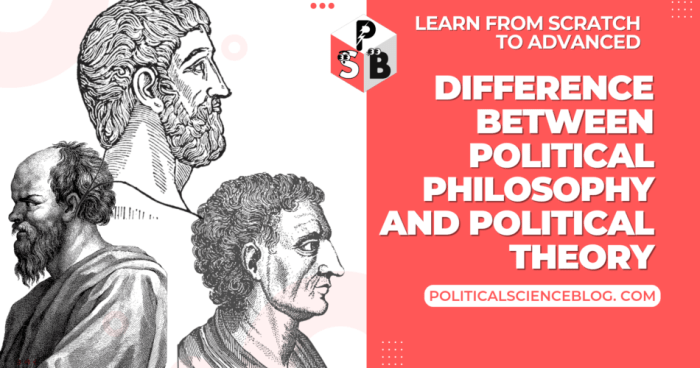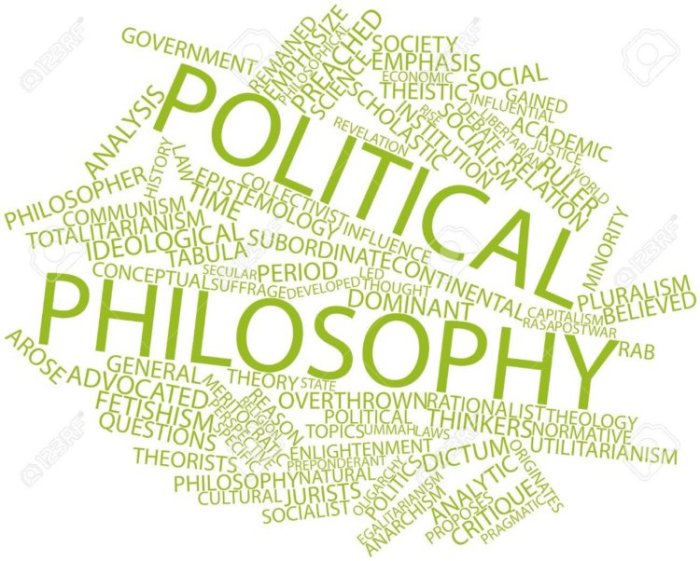
Delving into the impact of philosophy on political theory and practice, this exploration uncovers how philosophical concepts have influenced political ideologies throughout history. From shaping political practices to molding societal norms, philosophy plays a pivotal role in the realm of politics.
As we navigate through the intricate relationship between philosophy and politics, we will unravel the profound impact of different philosophical schools of thought on the evolution of political ideologies.
Impact of Philosophy on Political Theory and Practice
Philosophy plays a crucial role in shaping political theory and practice by providing the foundational principles and values that guide decision-making and governance.
Philosophical Concepts Shaping Political Practices
- The concept of justice, as discussed by philosophers like Plato and John Rawls, has influenced the development of fair and equitable political systems.
- The idea of natural rights, advocated by thinkers such as John Locke, has been instrumental in shaping democratic principles and individual freedoms in political practice.
- The concept of utilitarianism, proposed by Jeremy Bentham and John Stuart Mill, has impacted policies related to maximizing overall happiness and well-being in societies.
Impact of Different Philosophical Schools of Thought on Political Ideologies
- Liberalism, rooted in the ideas of individual rights and limited government, has been influenced by philosophers like Locke and Mill, shaping modern democratic practices.
- Conservatism, drawing from thinkers such as Edmund Burke, emphasizes tradition, hierarchy, and societal stability in political ideologies.
- Marxism, based on the works of Karl Marx, focuses on class struggle and the need for a revolution to establish a classless society, impacting socialist political movements.
Role of Painting in Political Discourse

Throughout history, paintings have served as powerful tools to convey political messages, ideologies, and critiques. Artists have utilized the visual medium to express their views on various political issues, challenge norms, and provoke thought among viewers.
Symbolism and Imagery in Famous Political Paintings
Many famous political paintings are rich in symbolism and imagery, carefully crafted by artists to communicate complex ideas and emotions. For example,
Guernica
by Pablo Picasso is a powerful anti-war painting that depicts the horrors of the Spanish Civil War. The use of monochromatic tones, distorted figures, and symbolic elements such as the bull and horse conveys the senseless violence and devastation of war.
- Liberty Leading the People by Eugène Delacroix is another iconic painting that symbolizes freedom and revolution. The figure of Liberty leading a diverse group of people over a barricade embodies the spirit of liberty and the fight against oppression.
- The Death of Marat by Jacques-Louis David is a poignant depiction of the murdered French revolutionary leader Jean-Paul Marat. The painting portrays Marat in a heroic light, emphasizing his sacrifice for the revolutionary cause.
Artists Challenging Political Norms
Artists have often used their works to challenge political norms and question authority. For instance, the surrealist movement, led by artists like Salvador Dalí and René Magritte, sought to disrupt conventional thinking and explore the subconscious mind. Their use of dreamlike imagery and symbolism was a form of rebellion against societal and political constraints.
- In more recent times, artists like Banksy have gained fame for their politically charged street art, addressing issues such as government surveillance, social injustice, and environmental degradation. Banksy’s works often challenge viewers to reconsider their perspectives on contemporary political issues.
- Yinka Shonibare is another artist who confronts colonialism and post-colonial identities through his vibrant and provocative art installations. By subverting traditional symbols of power and authority, Shonibare prompts viewers to reflect on the legacy of colonialism and its impact on society.
Influence of Performing Arts on Political Movements
The performing arts, including theater and dance, have long been powerful tools for political activism and social change. Through their ability to evoke emotions, convey messages, and engage audiences, performances have played a significant role in various political movements throughout history.
Role of Theater in Political Activism
Theater has been utilized as a platform for political activism, with plays and performances addressing social issues, government corruption, human rights violations, and more. One notable example is the Theatre of the Oppressed, developed by Brazilian activist Augusto Boal, which encourages audience participation and explores ways to challenge oppressive systems through theater.
Impact of Dance in Political Discourse
Dance, as a form of artistic expression, has also been used to convey political messages and spark change. The choreography, music, and movements in dance can symbolize resistance, unity, and solidarity within political movements. For instance, during the Civil Rights Movement in the United States, African American dancers used their art to protest racial segregation and inequality.
Relationship between Performing Arts and Political Propaganda
Performing arts have been utilized as a tool for political propaganda to influence public opinion, shape narratives, and promote government ideologies. Governments and political groups have commissioned performances, plays, and dance routines to promote their agendas and gain support from the masses. This relationship between performing arts and political propaganda highlights the power of artistic expression in shaping political discourse.
Philosophy in Photography

Photography has been a powerful tool for documenting and commenting on political events throughout history. Photographers use their art to capture moments that shape our understanding of the world and the political realities we live in. Through their lenses, they provide a visual narrative that can evoke emotions, spark conversations, and challenge perspectives.
Impact of Iconic Political Photographs
Iconic political photographs have the ability to shape public perception and influence collective memory. Images like “Tank Man” from the Tiananmen Square protests or the “Napalm Girl” from the Vietnam War have become symbols of resistance, suffering, and hope. These photographs transcend language barriers and cultural differences, resonating with people around the world and leaving a lasting impact on society.
- Photographs document history: They provide a visual record of political events that can be used to educate future generations and hold governments accountable.
- Emotional resonance: Iconic images have the power to evoke strong emotions and create empathy, mobilizing people to take action or support a cause.
- Shifting perspectives: Political photographs can challenge dominant narratives and offer alternative viewpoints, prompting critical reflection and dialogue.
Ethical Considerations in Political Photography
Using photography for political advocacy raises ethical questions about consent, representation, and manipulation. Photographers must consider the impact of their work on the subjects and the viewers, ensuring that their images are truthful, respectful, and serve a larger purpose beyond sensationalism.
- Consent and privacy: Respecting the dignity and rights of the individuals captured in photographs is essential, especially in sensitive or vulnerable situations.
- Objectivity vs. advocacy: Balancing the role of a neutral observer with the desire to advocate for social change requires careful consideration of the photographer’s intentions and biases.
- Context and manipulation: Presenting photographs without proper context or editing them to fit a specific narrative can distort reality and mislead the audience, undermining the credibility of the image.
Impact of Short Fiction on Political Awareness
Short fiction has proven to be a powerful medium for exploring political themes, allowing authors to convey complex ideas in a digestible and engaging format. Through the use of allegories and metaphors, writers can address political issues in their stories, providing readers with a new perspective on real-world events. The role of short fiction in shaping public opinion on political matters cannot be understated, as it has the ability to evoke emotions, provoke thoughts, and spark conversations about important social and political issues.
Exploring Political Themes through Short Fiction
Short fiction serves as a creative outlet for authors to explore political themes in a nuanced and imaginative way. By crafting compelling narratives and characters, writers can shed light on the complexities of political systems, ideologies, and power dynamics. Through the use of symbolism and subtext, short fiction can offer insightful commentary on current events and societal issues, prompting readers to reflect on the world around them.
- Authors often use allegories to represent real-life political figures or events in a fictional setting, allowing readers to draw parallels and draw their own conclusions.
- Metaphors are frequently employed to convey deeper meanings and critiques of political structures, policies, and institutions.
- Short stories can provide a platform for marginalized voices and perspectives, challenging mainstream narratives and expanding the discourse on political matters.
Shaping Public Opinion through Short Fiction
The emotive power of short fiction can influence public opinion on political matters by appealing to readers’ emotions and values. Through compelling storytelling and vivid imagery, authors can sway readers’ perspectives, ignite empathy, and inspire action on pressing social and political issues.
- Short fiction can humanize political issues by putting a face to abstract concepts, making them more relatable and personal to readers.
- By presenting diverse viewpoints and experiences, short stories can broaden readers’ understanding of complex political issues and foster empathy towards different perspectives.
- Authors can use short fiction to challenge prevailing narratives and provoke critical thinking about the status quo, encouraging readers to question and reevaluate their own beliefs and assumptions.
Visual Graphic Arts
Visual graphic arts play a crucial role in political protests and movements by effectively conveying powerful messages through images. The combination of text and visuals in mediums such as posters, cartoons, and infographics has the ability to capture attention, evoke emotions, and persuade viewers to take action.
Role of Graphic Arts in Political Protests
- Political posters have been used throughout history to raise awareness about social issues, promote political ideologies, and mobilize support for various causes. For example, iconic posters like “We Can Do It!” featuring Rosie the Riveter during World War II became symbols of female empowerment and encouraged women to join the workforce.
- Cartoons, with their satirical and humorous approach, have been effective in critiquing political figures and policies. Artists like Banksy use street art to make bold statements on topics such as government surveillance and social injustice, sparking conversations and provoking thought.
- Infographics present complex data and information in a visually appealing and easy-to-understand format. They have been utilized in political campaigns to educate the public on important issues like climate change, healthcare reform, and economic inequality.
Examples of Influential Visual Art in Politics
- The “Hope” poster created by artist Shepard Fairey for Barack Obama’s 2008 presidential campaign became an iconic symbol of optimism and change, resonating with voters across the country.
- Political cartoons by artists like Thomas Nast played a significant role in exposing corruption in 19th-century American politics, leading to public outrage and reforms.
- Infographics illustrating the impact of gun violence in the United States have been instrumental in advocating for stricter gun control laws and promoting safer communities.
Power of Visual Imagery in Mobilizing Support
- Visual imagery has the ability to evoke strong emotions, create a sense of unity among supporters, and inspire action. Images that depict human rights violations, environmental destruction, or social injustice can galvanize individuals to participate in protests, sign petitions, or donate to causes.
- By using striking visuals and compelling narratives, graphic arts have the power to shift public perception, challenge existing norms, and drive change in society. They serve as a catalyst for political movements, sparking conversations, and influencing policy decisions.
In conclusion, the intricate interplay between philosophy and political theory illuminates the underlying principles that govern our political landscape. By understanding the impact of philosophy on political practices, we gain a deeper insight into the complexities of governance and societal structures.
Key Questions Answered
How does philosophy influence political theory?
Philosophy shapes the foundation of political theory by providing the underlying principles and values that guide political ideologies.
Can you provide examples of philosophical concepts that have impacted political practices?
Aristotle’s idea of democracy and Plato’s concept of philosopher-kings are significant examples that have influenced political practices.
What is the significance of comparing different philosophical schools of thought in political ideologies?
Comparing philosophical schools helps in understanding the diverse perspectives that shape political ideologies and governance systems.





